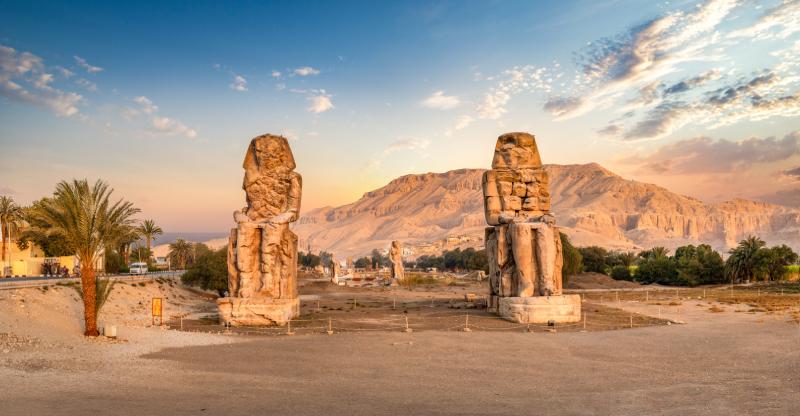
The Colossi of Memnon, two towering statues of Pharaoh Amenhotep III, stand as enduring symbols of ancient Egypt's grandeur. Once part of a vast mortuary temple, these 18-meter-tall figures are marvels of ancient artistry. Carved from quartzite sandstone, they’ve captured imaginations for centuries,not only for their scale but also for the legend of the “singing statues,” a mysterious sound said to echo from one of them at dawn. Though the temple they guarded is long gone, the Colossi remain iconic sentinels of Egypt’s glorious past, drawing travelers and scholars alike.
The Colossi of Memnon stand on the west bank of the Nile near Luxor, in the heart of the Theban Necropolis. Once guarding Amenhotep III’s mortuary temple, these statues marked a sacred gateway to the pharaoh’s afterlife. Their placement reflects both religious symbolism and a strategic connection to the Nile. Today, the site is easily accessible from Luxor and offers visitors a chance to explore not only the colossal statues but also nearby treasures like the Valley of the Kings and the Valley of the Queens.

The construction of the Colossi of Memnon dates back to the 14th century BCE, during the reign of Pharaoh Amenhotep III, one of Ancient Egypt's most powerful rulers. Amenhotep III's reign marked a period of prosperity and artistic flourishing, and his mortuary temple complex was a testament to his wealth and influence. Although little remains of the temple itself, the Colossi were designed to stand at its entrance, welcoming the Pharaoh's spirit into the afterlife.
Carved from quartzite sandstone transported from near Cairo, the Colossi of Memnon have endured centuries of weather and damage. A major earthquake in 27 BCE caused cracks that led to the legend of the “singing statues,” as wind whistled through the fissures. During Roman rule, visitors left inscriptions still visible today,evidence of early restoration attempts and the lasting intrigue surrounding these ancient monuments.
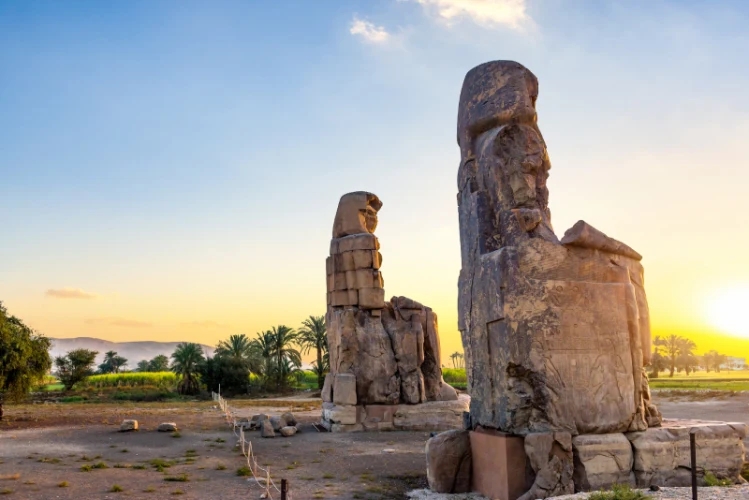
The Colossi of Memnon are marvels of ancient engineering and artistry. Each statue is carved to represent Pharaoh Amenhotep III seated on a throne, with his hands resting on his knees and a serene expression on his face. The statues are adorned with symbolic carvings, including images of the Nile god Hapi, which emphasize the Pharaoh's divine connection and his role as a bridge between the mortal and the godly realms.
The Colossi of Memnon were built using massive quartzite blocks weighing over 720 tons, showcasing the ancient Egyptians' engineering expertise. These statues symbolize their advanced technological and architectural skills, offering valuable historical insights.
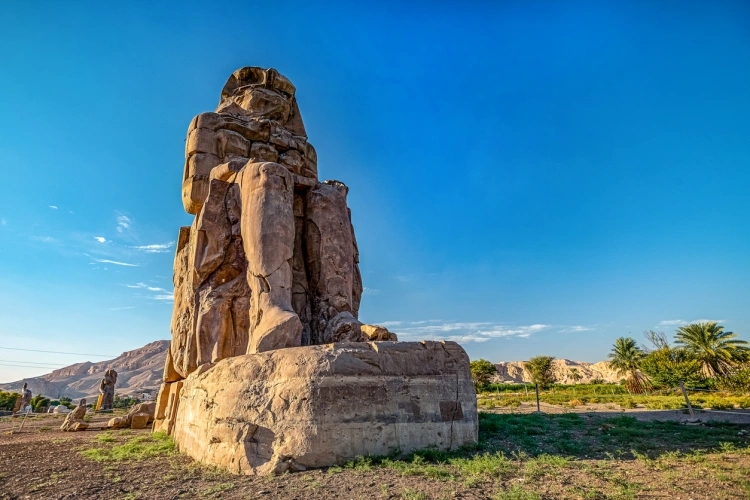
The phenomenon of the "singing statues" is one of the most intriguing aspects of the Colossi of Memnon. After the earthquake in 27 BCE caused cracks in the northern statue, visitors began to report hearing a mysterious sound emanating from the figure at dawn. This sound was described as a melodic hum or moan, resembling a musical note or a human voice.
Ancient Greeks and Romans were captivated by this acoustic curiosity, attributing it to the mythical figure of Memnon, the son of Eos, the goddess of dawn. According to legend, Memnon was a hero of the Trojan War who was slain by Achilles. His mother, Eos, wept for him every morning, and the Colossi's "singing" was thought to be his voice responding to her lamentations.
This legend transformed the Colossi into a pilgrimage site for those seeking to witness the supernatural occurrence. Visitors recorded their experiences and interpretations of the sound, adding layers of myth and cultural significance to the statues. Although the singing ceased following restoration efforts in the 3rd century CE, the legend of the "singing statues" endures, adding a mystical dimension to the already fascinating history of the Colossi.
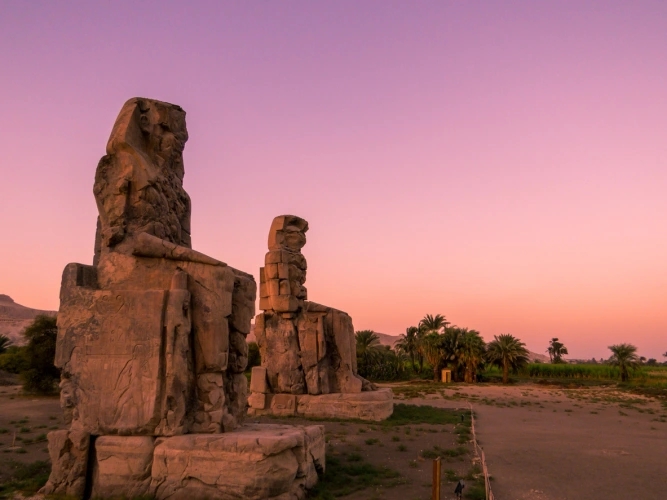
Choosing the right time to visit the Colossi of Memnon can enhance the overall experience, as the climate in Luxor can vary significantly throughout the year. Generally, the best time to visit is during the cooler months from October to April, when temperatures are more comfortable for exploring outdoor sites, especially for those planning their Egypt Tours.
During these months, visitors can enjoy pleasant weather, with temperatures ranging from 20°C to 30°C (68°F to 86°F). Early mornings or late afternoons are ideal for visiting, offering softer light, fewer crowds, and a peaceful atmosphere.
The Colossi of Memnon are steeped in fascinating facts and stories that add to their allure. Here are some intriguing tidbits about these ancient statues:
1. Dual Purpose: Originally, the Colossi were not standalone structures. They flanked the entrance of Amenhotep III's mortuary temple, serving both an ornamental and protective role.
2. Global Recognition: The Colossi have been mentioned in numerous ancient texts, including those by Greek historian Strabo and the Roman author Pliny the Elder, highlighting their significance even in ancient times.
3. Cultural Exchange: The site was a melting pot of cultures and beliefs, attracting visitors from across the ancient world. Inscriptions left by travelers in Latin and Greek provide a window into the diverse interactions that took place at the Colossi.
4. Restoration Efforts: Over the centuries, several restoration attempts have been made to preserve the Colossi. The most notable was undertaken by the Roman Emperor Septimius Severus, who repaired the northern statue, inadvertently silencing its "singing."
5. Symbolic Throne: The statues' thrones are adorned with intricate carvings depicting scenes of the Pharaoh's unification of Upper and Lower Egypt, reinforcing Amenhotep III's role as a powerful and divine ruler.
These facts underscore the Colossi's enduring appeal and their importance as cultural and historical landmarks.
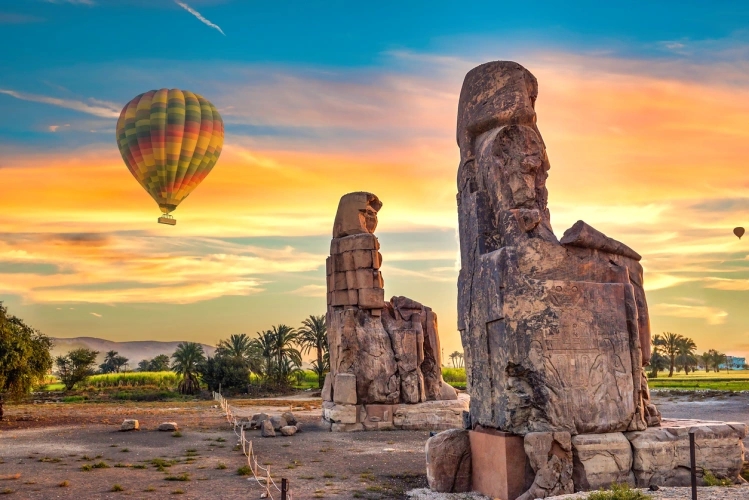
The area surrounding the Colossi of Memnon is rich with archaeological and cultural sites that complement a visit to these iconic statues. Here are some must-see attractions nearby:
1. Valley of the Kings: Located a short distance from the Colossi, this valley is home to the tombs of many ancient Egyptian pharaohs, including Tutankhamun. The intricate tomb paintings and hieroglyphs offer a glimpse into the beliefs and artistry of the time.

2. Temple of Hatshepsut: Situated at Deir el-Bahari, this mortuary temple dedicated to Queen Hatshepsut is renowned for its unique architecture and stunning reliefs. The temple is a testament to the power and influence of one of Egypt's most successful female pharaohs.
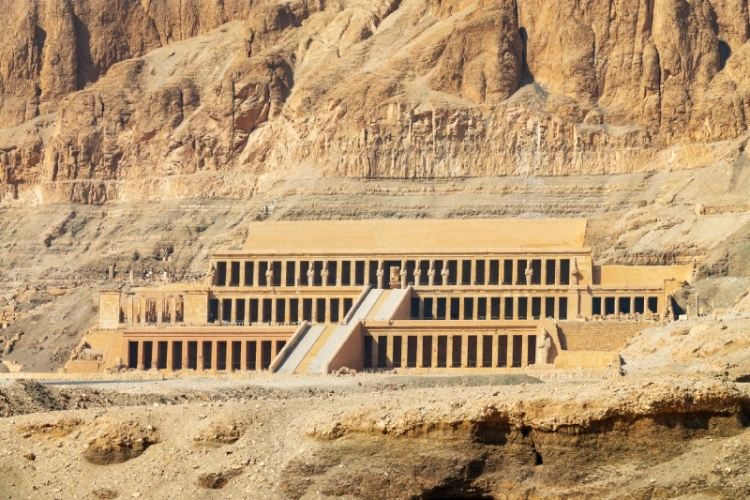
3. Karnak Temple Complex: One of the largest religious complexes in the world, Karnak is a marvel of ancient engineering. Its massive columns, obelisks, and statues are a testament to the grandeur of the New Kingdom period.

4. Luxor Temple: Luxor Temple is an ancient Egyptian temple on the east bank of the Nile in Luxor, built around 1400 BCE. Dedicated to the Theban Triad,Amun, Mut, and Khonsu,it celebrated the renewal of kingship, not the afterlife. Central to the Opet Festival, it is connected with Karnak Temple. Its impressive columns, statues, and obelisks highlight New Kingdom grandeur.
These attractions, along with the Colossi of Memnon, provide a comprehensive exploration of Egypt's rich history and the remarkable achievements of its ancient civilization.
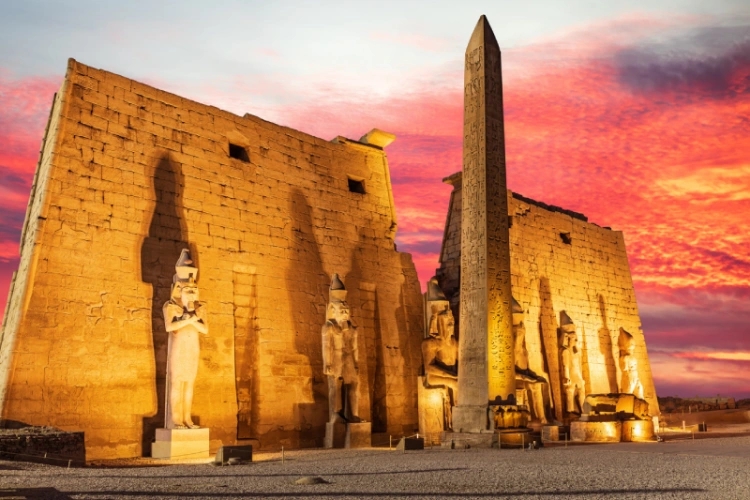
The Colossi of Memnon stand as timeless guardians of Egypt's storied past, captivating visitors with their grandeur, history, and the myths that surround them. From their architectural significance to the legends of the "singing statues," these ancient figures offer a profound connection to a world long gone yet ever-present in the imagination.
For those planning a journey to Egypt, the Colossi of Memnon offer an unforgettable experience in Luxor, steeped in history and legend. Book your Egypt Tours now and explore these monumental statues, discovering the wonders of Ancient Egypt.
Q1.What is the Colossi of Memnon?
The Colossi of Memnon are two massive statues of Pharaoh Amenhotep III, located on the western bank of the Nile near Luxor, Egypt. They are iconic remnants of a mortuary temple that no longer exists.
Q2. Where are the Colossi of Memnon located?
The Colossi of Memnon are situated in the Theban Necropolis, on the western bank of the Nile River, near Luxor, Egypt.
Q3. Why are the Colossi of Memnon famous?
These statues are famous for their immense size, historical significance, and the legends associated with them, especially the myth of the "singing statues."
Q4. Who built the Colossi of Memnon?
The Colossi were built during the reign of Pharaoh Amenhotep III in the 14th century BCE as part of his mortuary temple.
Q5. What is the myth of the "singing statues"?
The ancient legend suggests that the statues made a mysterious sound at dawn, thought to be the voice of Memnon, the mythical son of the goddess Eos. This sound was attributed to the wind passing through cracks in the statues.
Q6. How tall are the Colossi of Memnon?
Each of the statues stands approximately 18 meters (60 feet) tall.
Q7. Can I visit the Colossi of Memnon?
Yes, the Colossi of Memnon are a popular tourist attraction in Luxor and can be visited as part of the Theban Necropolis tour.
Q8. What should I expect when visiting the Colossi of Memnon?
Visitors can expect to see the towering statues in a peaceful desert setting, with opportunities for photography and exploration of the surrounding area, including nearby archaeological sites.
Q9. What is the best time to visit the Colossi of Memnon?
The best time to visit is during the cooler months, from October to April, when the weather is mild and more comfortable for sightseeing. Early mornings are ideal to avoid crowds and capture the statues in the soft light.
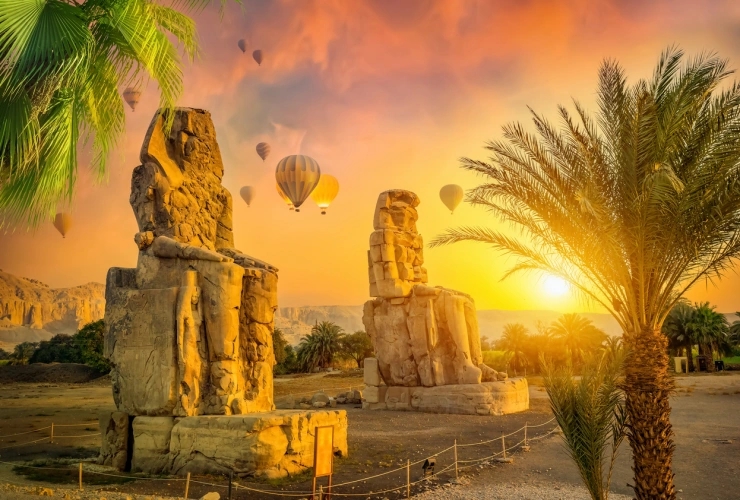

© Copyright 2025 Get Egypt Tour. All rights reserved.